#whatafterbarch
Text
Interview series - What after B.Arch? #16
Interviewee: Ar. Valentin Gheorghian
Post-graduation: Masters in Architecture | Gheorghe Asachi Technical University of Iași, Romania
What prompted you to take up Architecture?
I wanted to become an Architect ever since we had a school assignment in 4th grade at a subject called “technology” when we had to draw our “ideal house” for us and our family. I loved that assignment so much, took a long time to do it properly, and with excellent results – that then and there I decided this is what I would like to do for a living and started to buy architecture magazines/ magazines with houses.
Tell us about studying Master of Architecture at TUIASI.
In Romania architecture studies comprise of 6 years and result in gaining both degrees: Bachelor’s and Master’s. One cannot do just the first one – the first one is meaningless. You are not considered a graduate before you finish year 6, pass all your exams and pass the Graduation/ Degree project (final project, 6 month long).
After graduating Year 4, you continue with Year 5 – which is – in theory – already “Master” level – but nothing changes – it’s a continuous 6 year study cycle, no interruptions, same school, same teachers, same colleagues – only different subjects (more advanced), more projects and more complex projects.
Tell us about the application process.
There is no “application process” in the way it’s understood in the UK – one has to pass a gruelling admission exam at one of only 6 universities in the country that have Architecture departments. For that 5-6 hour exam, students train – via private tutoring – for at least a year – because the examination requires excellent hand drafting skills, technical drafting skills and advance descriptive geometry – none of which is being taught in high-schools; in that lies the need to take on private tutoring.
One should start with the application process for 2 years in advance.
What preparation did you do before starting the program?
There were 10 days of intensive drawing courses – both technical and hand drafting – organised by the university just before the admission’s exam. These were good and useful for someone who already knew what they were doing – but pointless for someone who didn’t have a clue. Students take a minimum of 1 year of difficult private tutoring (with a lot of homework) to get to the drawing (both technical and freehand) skill level required to pass the admission examination.
In terms of pre-reading for the program– I’ve always enjoyed reading about architecture and buildings – but especially about historical buildings/ cities and the history of architecture.
Did you speak to any alumni/professors of the program?
I hadn’t met any architecture students or young architects before joining the program – and it would have been extremely useful to gain some insights and tips & tricks and the subtleties of the university. Had only met old architects/ teachers – the ones with whom I did private tutoring to prepare for my admission exam.
Did you have to give any entrance tests? How did you plan for them?
The 6 years integrated study program has a 5/6h entry examination testing freehand drawing, technical drawing and mathematical/ geometry skills. One trains in private for at least 1 year for these.
How long was your program?
6 years – October 1st 2007 – October 2013. There is no flexibility regarding fall/spring semesters.
Did you have post-study plans in mind when you took it up?
Just went with the flow. Now, however, I am planning to do a PhD in a related field and go into teaching at an Architecture University - because I am astonished about the low wages in the Architecture field - as opposed to other skilled careers - and I would do this as a way to supplement my income. I love teaching as well and I think it would be an excellent for for me - but the main reason is the financial one.
Did you have to apply for a visa?
Non-applicable – neither in my home country of Romania (where the bulk of the program took place) – nor during the time spent abroad – which was all spent inside the EU – thus not requiring visa.
How was the experience at the school?
Very difficult yet very rewarding at the same time. Longer hours, more courses, more seminars, more projects and more time spent on projects – than any other university that I know of. Less time for socializing and leisure activities than any other students. Longer academic year: from the 1st of October – start of the academic year – until mid-July (end of “practical training” week/ weeks)
How was the teaching and learning environment at your school?
Every class (year of study) had their own classroom - 6 years of study – 6 classrooms. There were roughly 50 people per year of study/ class – but never would everyone show up (except perhaps some exams) – so everyone could fit in. Apart from these 6 classrooms – there were 2 multi-function rooms/ projection rooms, amphitheatre type (although not sloped) for projections and special presentations, and an IT lab with computers. That’s it – those were all the available spaces (small school, intimate, student-oriented).
Classical style of teaching – you go in class – just like during high-school – and the teacher teaches for 2h their subject – with either a 10min break between classes, or a small 5min cigarette break mid-way. Most difficult or practical subjects also had “seminars” same duration, same location – during which we would do exercises and problem solving
The frequency of the classes depended on the year of study. The busiest teaching schedule was in year 1 – and decreased progressively towards year 6 – when there are no taught classes at all (only non-supervised individual work on the final project, “degree project” and on the Dissertation – at the same time). Year 1: 6-8hours of classes per day, every day. Year 5: about 3-4hours per day. Year 6: 0. The decrease in number of taught hours was compensated by an increase in number of projects (like “homework”): in year 1 students only had to work on projects in the main school subject, “architectural design” (counting for half of all study credits). This grew up to year 5 – when there were projects to be worked on at home for at least 10 school subjects, such as: urban planning, interior design, special structures, construction materials, and so on.
There was no time for other things – not even a shade of social life. Architecture life occupies ALL your time, at least during uni.
Tell us more about the mentors.
One would meet mentors/ teachers/ assistants whenever one could find them around the school or in their office – in years 1-5. There was no formality in the method used to meet with them, no “appointments”, nothing like that. In year 6 – final year – it would be even easier – one would have personal contacts for one’s degree/ final project mentor, as well as a few others with whom one would have a close collaboration for their final project – such as a structural engineer/ structures professor. These meetings would either take place somewhere in the university – or at that teacher’s private practice – most if not all of them also had their private practices and would be project architects on their own. Despite this ease in meeting and approaching – there was and is a much higher degree of formality in addressing/ interacting with teachers – as compared to the
UK or the west. One would NEVER address a teacher/ tutor/ assistant by their first name, for example; that would be a sign of huge disrespect.
Did your institute have any support system for international students?
Any incoming international students would come through the Erasmus program, and would stay for half a year, usually in years 3 or 4. There were very few of these – maybe 2-3 per academic year – due to the fact that Romanian architecture and architecture education is completely unknown internationally.
As a general rule – these internationals would live like princes – would enjoy a much easier life than locals/ regulars. The teachers were way more lenient towards them – on one hand – so they would get high marks regardless of their academic performance, and on the other hand – they always had money. Erasmus scholarships barely cover half of one’s living costs in a country such as France (where I had studied as an Erasmus student) – but are way more than needed in a cheap country such as Romania – so sweet life!
Were you involved in research projects while studying?
I was involved in all research projects, volunteering activities, publications, work camps and anything related to the subject, both internally and abroad – as visible from my CV. Those abroad were taking place in either English or French. I’ve never seen/met any students from the UK taking part in any of these – thus gaining the impression that UK students are very inward-looking – as opposed to EU students who are very open-minded and open and international and love foreign exchange programs and so on.
Tell us about your time abroad?
My 6 month Erasmus program was spent in ENSAP [École Nationale Supérieure d'Architecture et de Paysage] Lille, France - and I lived on campus through the duration of the exchange.
It was a brutally difficult program - not because of the academic level, which wasn’t any higher than back in Romania - but because of the density of classes, amount of project work outside of hours spent in uni, and the (lack of) dedication of my teammates (all projects were done in teams). I regret not having more fun and a social life during my Eramsus - such as most of my friends had - those who went to different countries and destinations - but there was nothing I could do about it.
Could you tell us in brief what your thesis/dissertation/final project was about?
My thesis/ dissertation was about gentrification and urban regeneration – with case studies of several post-industrial global cities: Paris, Brussels, Sao Paulo, Shanghai and Detroit; contemporary urban challenges – in very different political/ social/ economical contexts. Differences, similarities, solutions. My final project was an Immigrants Integration Centre in central Paris – combining urban regeneration of a brownfield (urban planning part) with architectural design of 9 individual buildings – a small “city within a city”
The dialogue with my supervisor went smooth and on friendly terms – one chooses their supervisor based on one’s previous grades – and as I finished years 1-5 3rd in my generation (3rd highest score) I could obviously choose whichever tutor I wanted – and chose the one that I had the best relationship with.
What were the frequency, duration and structure of the meetings with supervisor?
All of this was flexible and down to our own (me and the tutor’s) preferences, schedules and available times. Usually we would meet either in my tutor’s practice or at university, for a couple of hours, every 2 weeks or so, and go through the work. Sometimes I would send the latest over email the day before – just to give them the chance to take a look and make some notes – but this wasn’t always possible.
What challenges did you encounter?
The scale of my project and complexity and limited time. I practically managed to finish a volume of work 5 times greater than most of my peers. Practically in 6 months’ time, I did my urban planning dissertation project (a 65-page theoretical analysis, on the subject mentioned above), the urban design of my site, and the full architectural design of 9 large buildings, plus the presentations and graphics of all the aforementioned.
How did you manage the finances?
There is NO tuition fee – Education is completely free in Romania – for all levels all the way up to PhD. One only needs to cover for living expenses. My parents covered my living expenses – which – in Iasi, Romania – amounted to less than 200GBP/ month. For example: monthly rent in student dorm: about 50 GBP- all expenses included (heating, electricity, broadband, and so on); local transport card – unlimited travel – 1 month – about 5GBP (yes, five, I am not missing a zero or two J). Some people worked part time/ full time to cover for some/ all of their living expenses. Given the fact that school work required at least 70 hours per week (total - both “home” and “in class”) meant that those who worked were not very good students, and usually missed/ skipped class.
Did you volunteer/work part-time job/intern while studying?
I did only a short stint just before year 6 in a small architectural practice in a small city. It is compulsory to work for 3 months in a supervised way in a practice – and submit reports of what exactly you have been doing there – to be accepted to begin your final/ graduation project and dissertation. I got the job through an older friend’s recommendation – she had already been working there.
How did you choose your accommodation?
I chose a student residence on the university campus. In year 1 nobody is allowed to choose – one is simply allocated a place in a student residence in the campus – if one doesn’t wish to live elsewhere (rent out) – but after graduating year 1 – places are given based on the student’s past performance and grades – and one is allowed to choose. Based on my marks – I always finished among the top 5 people from my class – I always chose what I wanted….though there wasn’t much difference between residences. The ”commute” was a 20min walk – from campus to the Architecture School (all classes and exams took place in the same building – the architecture school building – up to year 5; in years 5 and 6 one might have to do some assignments in a few other buildings – all actually closer than the architecture building)
I considered several factors such as campus student life, proximity and contact with colleagues, proximity to the university, proximity to the shopping mall (there was 1 shopping mall in the city – right there next to campus), social contacts, costs – much lower than renting out while choosing my accommodation.
Did you travel while studying?
I had never visited another country before university. By the end of university, I had travelled to over 20 European countries, mostly for studying their culture, architecture and history. Did a 6 month long Erasmus exchange program in France (at ENSAP Lille), an international volunteer restoration work camp in St. Tropez (France) as well as summer universities and specialization courses every summer during my studies – such as at the Bauhaus Architecture school in Dessau, Germany.
How do you think the Master’s degree helped you?
By allowing me to be a registered Architect in the UK, EU and RO. Without it I could have only worked as a “draftsperson”
Did the city you studied in play a major role during your study?
Yes it did – Iași is a great city to study in – perfect size for a university city (a third of the city is student-population), cheap, interesting, cultural, laid-back: https://en.wikipedia.org/wiki/Ia%C8%99i
Could you tell us about your current work and future plans?
I’m working as an Architect and BIM specialist in central London. Depending on the economic prospects in Britain after Brexit – I might move back to France. It was a gamble moving here – having to choose between Paris and London – between the Euro and the Pound Stirling – and the balance tipped in favour of the UK because the GBP was a more valuable currency at the time. Right after the Brexit vote, the Pound dropped by 20% in value – on international markets. What can I say? Very bad timing…my reasons for being here (and not elsewhere) keep disappearing.
Looking back was there anything you would have done differently?
I really wish I had worked less and had more fun. I could have had a similar result by working smarter but less – and having more fun. I’d always been afraid to not be a workaholic and go above and beyond. Too bad.
What message would you like to give those planning their post-graduate studies?
Think about actual job prospects and the career you want to pursue – and study the market; plan accordingly. Work smart, don’t work more! Have fun – in a smart way – these years are never coming back! Social interaction will never be as easy and with so many opportunities ever again – take full advantage of this! It’s all downhill after graduation – in terms of social life ☺ Seriously, no kidding…

Presenting our team's project at EBEC [European Best Engineering Competition] Romania & Republic of Moldova - National Stage
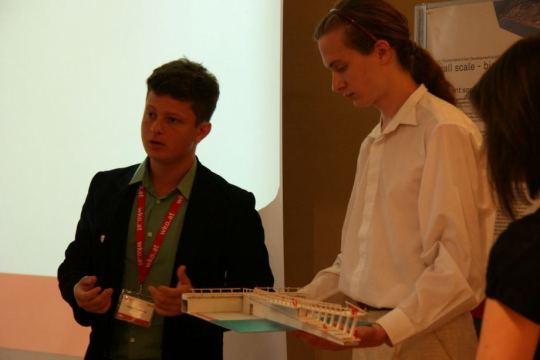
Presenting our team's project - and winning first place - at SUC 12 [Summer University Carinthia] - Villach, Austria
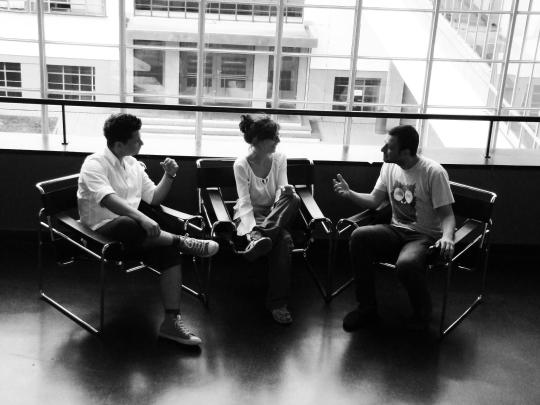
Architect's chat at Bauhaus Summer University, Dessau, Germany
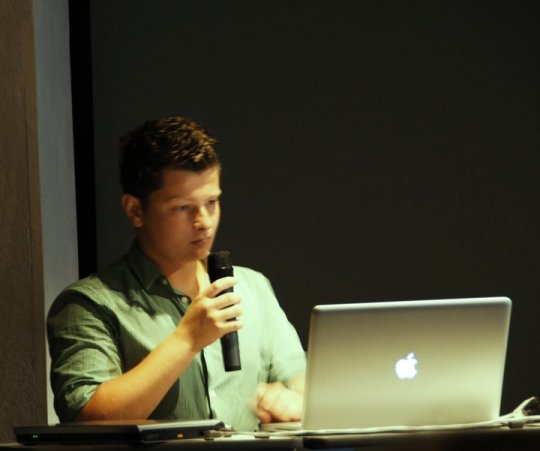
Presenting a school project in front of the Dean of Harvard Universty - Graduate School of Architecture and Design

Specialization course in Kosice, Slovakia - international team
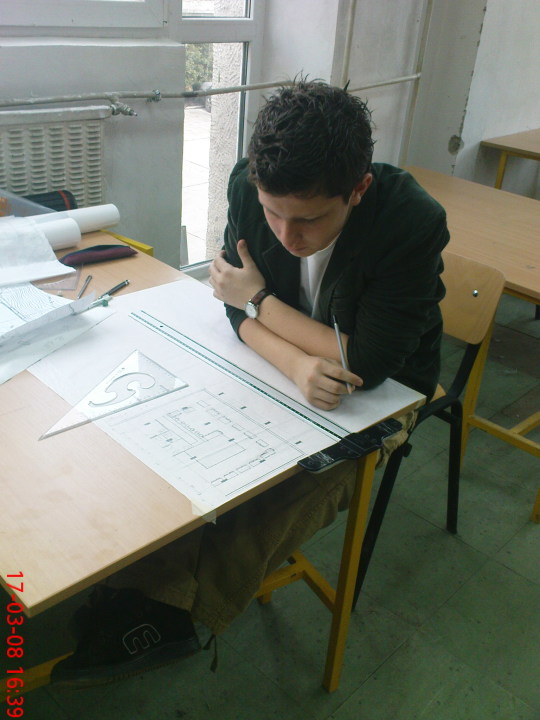
Year 1 - working in the studio - hand drafting

Year 1 or 2: working in the university student dorm
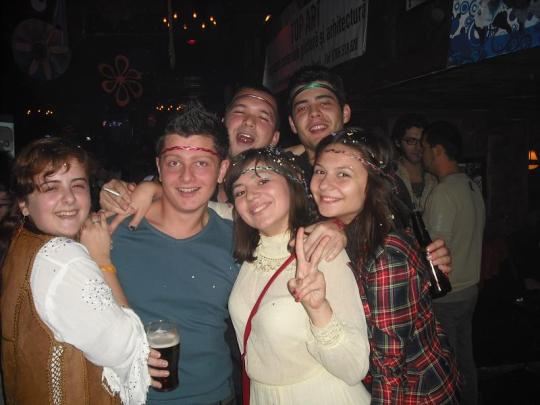
With colleagues from uni
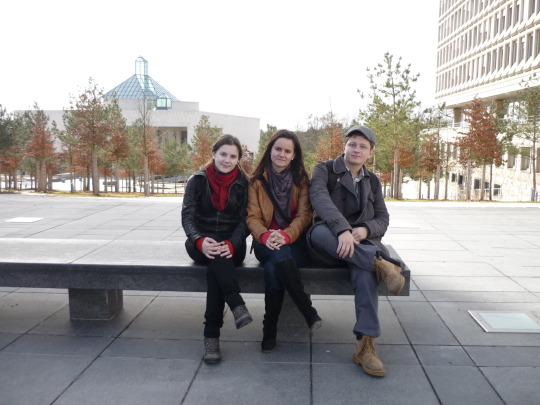
Exploring Luxembourg's contemporary architecture - European Quarter

Study trip in Venice for the Architecture Biennale
#Architecture#architecture students#romania#masters in architecture#iași#whatafterbarch#architect#Architects
2 notes
·
View notes
Text
Interview series - What after B.Arch? #12
Interviewee: Ar. Lolia Mary
Post-graduation: Masters in Environmental Planning | School of Planning and Architecture, New Delhi, India
What prompted you to take up this particular program?
I felt the need to focus on larger scales and broader perspectives of development, to understand the dynamics of how and why we have different types of built landscapes across various regions. By the 4th year in my undergraduate study, I was gravitating towards learning more about natural systems and environmentally sustainable designs. Master’s in Environmental Planning was the most appropriate course, which fit my inclination and interest w.r.t scale and natural systems.

When did you take up master’s?
I got into Master’s course immediately after Bachelor’s.
My advice is simple: if you have a clear inclination towards further studies and have examined why you need to pursue a master’s course and a preferred subject, I don’t think you should stop yourself from immediately joining a course. But if you are inclined to practising Architecture in the long run and do not feel the need to further your studies immediately then you might want to get into practice. This will buy yourself more time to think through.
When did you start with the application process considering the time for application, scholarship/bursary deadlines etc.?
I started enquiring and doing my research on the application process, subjects/courses, colleges etc. around the beginning of the 5th year of the course. Of course, towards the last semester in Architecture, it was more intense.
One should start researching, reviewing courses and colleges at least a year before (if not a year and a half). This will give you more options and enough time to weigh your options. If planning on taking up courses outside of India, then one might want to give oneself at least 15 months’ time so as to not miss courses starting at different times of the year.
What preparation did you do before starting master’s?
I did some background study on environmental planning and prepared for moving to a new city. The school did not hold any pre-master’s programs/induction week/courses. I spoke to alumni and professors of the program.
Did you have to give any entrance tests? How did you plan for them?
SPA’s admission procedure at that time (2010) had two stages of candidate evaluation;
Stage 1) Detailed application form submission (Statement of Purpose, Portfolio-CV, and application form, Scorecards in Architecture and Scorecard of GATE exam)
Stage 2) Short-listed candidates are called in for a short written test and an Interview thereafter
Based on the results of these stages of review, the final list of successful candidates is put up.
It is ideal if you also qualify and secure a good rank in GATE; this will increase your points at the admission ranking and also help secure GATE scholarship.
How long was your program?
It was a two-year course. Courses began in July 2010 and ended in April 2012. Post-program opportunities were not available.
Did you have post-masters plans in mind when you took up masters? Or did you go with the flow?
My intent was to work in planning and environmental sector wherein I gain experience while working in all types of organizations (research-based organizations, government based, NGO, corporate etc.). I had given myself the flexibility for seeking job opportunities with an open mind initially, so it was easier to go with the flow. My idea was that I need to experience each type of organization to better understand how the sector itself functions.
How was the experience at the school?
It was quite rewarding given the exposure received especially to be able to hear and learn from pioneers, decision makers and change makers of planning and development in India. There is no stopping on how much one can learn because it is up to the individual to take initiative.
Even though at times chaotic with multiple perspective and reasonings, this chaos opens one’s horizon of knowledge and gives you the grounding required to understand planning and development in a developing nation like ours which is much complex unlike developed nations. This is my take.

How was the teaching at your school?
The teaching was heavily anchored on in-depth research (within the constraint of time), brainstorming, discussions, group work and field work. This is important so as to learn; how to agree to disagree, resolve conflicts and evolve balanced recommendations considering multiple aspects. This skill is fundamental while practising the profession of planning as it is multi-sectoral in its nature of practice on ground.
Classes were a standard 9.00am-5.00pm, five days a week with occasional special classes during Saturdays. Yes, there was quality time for extracurricular activities.
Tell us more about the mentors.
All the faculty in Department of Environmental Planning were very approachable (they still are) and one could approach them at their department rooms freely and they were accessible except when they were occupied with prior appointments.
I’d like to especially remember and thank Prof. Aseesh Maitra, Prof. Meenakshi Dhote, my thesis guides Ar. Anita Tikoo and Asst. Prof. Neha Tripati Goel for their wisdom, inspiration, patience and endurance.
Were you involved in research projects/competitions while studying?
Partly, through our studio and department projects.
Could you tell us in brief what your thesis/dissertation/final project was about?
It was on developing a model framework to evaluate landscape for its functional capacity to perform ecosystem services.
What kind of dialogue did you have with your professors?
I had the best thesis guides I could ask for. Ar. Anita Tikoo and Asst. Prof. Neha Tripathi Goel were exactly who, I and my topic needed. They always asked the right questions and also encouraged and stirred me to ask the right questions. They were open to hearing my thoughts and provide excellent critique was truly involved as my thesis guides. I think asking the right questions and encouraging us to ask questions pushes one to seek answers ourselves and thus expand the scope of learning.
How was the structure of your meetings with the guides?
We had a structure and a tentative schedule with targets applicable to all students. But over and above both my thesis guides were available for discussions whenever I required, to review with them. We had discussions before the scheduled submission and presentation of the work.
Did you encounter any challenges while doing your thesis?
I cannot remember any negative challenge. Thesis is about taking up a challenging research-based topic which you try and engage with in-depth for the given time. And a good thesis topic shouldn’t and cannot end with the final submission or jury presentation because it would have a further scope of examination and enquiry.
Could you please tell us about the thesis assessment system?
We had intermittent presentation and grading through the various stages of the thesis semester. It concluded with a final jury presentation (external and internal jurors) and submission of the report.
How did you manage the finances?
Fully funded by my kind and loving parents as I hadn’t received any scholarship.
Could you tell us about your accommodation?
Stayed in the campus hostel. The hostel building was right at the campus and barely took 5 minutes to walk to the department.
Did you travel while/after studying?
Yes. As much as I could.
Through Architecture and Environmental Planning course, I travelled to Jaisalmer, Jaipur, Udaipur, Junagadh, Kutch, Ahmedabad, Hyderabad, Puri, Bhubaneswar, Varanasi, Sarnath, Nainital, New Delhi, Agra, Fatehpur Sikri, Bhopal, Batindha, Puducherry; with the intent of experiencing the city and architecture, some were part of the studio projects/thesis and some places were purely leisure.
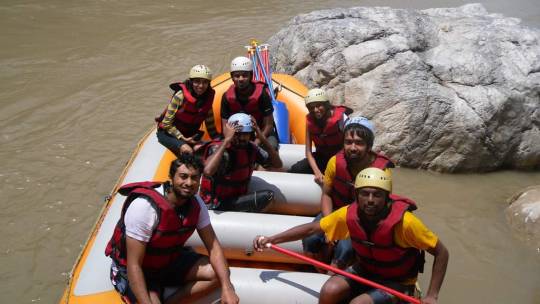

Are there any notable incidents/ anecdotes from post-grad studies that you wish to share?
I can’t think of any one incident. I often tell people it was so much fun learning and going to the classes especially because we were a small group of 12 students (12-15 seats in M.EP course) and luckily we synced and worked very well together through consensus and disagreements. Of course, all the campus extracurricular activities and travelling was awesome, thanks to a lot of friends from my B.Arch times who were also studying various Master’s courses.
How much one learns and grows is up to the individual. Professors and guidance can only show you the options and directions available and it’s entirely up to you to choose the path of your interest/capacity. And for that self-reflection is important.
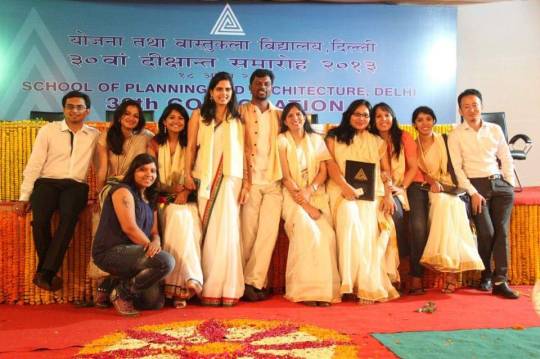
How do you think doing a master’s degree helped you?
Unlike many other courses which are focused on individual students and individual projects; planning requires persistent and successful collaboration across sectors and specialized professionals. Apart from the learning of the subject and the way it was taught, one of the important takeaway was, the first-hand experience of the strength of collaboration which enabled a smooth transition into the profession, especially in the initial years.
The university met my expectations to a great extent. The information about the course on the website reflected reality.
Did the city/country you studied in play a major role during your postgraduate study?
Yes. At least for Planning course, it ensured a sound foundation of the context (social, political, economic and environmental) that I would be working in for the next 7 years.
Could you please tell us about your current work and future plans?
I am currently working remotely as a consultant for a project and another programme run by an NGO. I am quite adaptive in nature, so my future plans are also very dynamic. My area of interest is applied research and hence I am open to any good platform that enables it.
What message would you like to give to students/professionals planning their post-graduate studies?
Well, whichever course one chooses, ensure that you know why you want to take up the course (for whatever reason be it professional, ideological, or simply self-growth). Do your research on the various options that you have w.r.t courses, universities and locations worldwide.
About the interviewee…
Lolia Mary is an Architect and Environmental Planner and has been working in the sector for the past 7 years. She completed her Postgraduate course (Master’s in Environmental Planning) from the School of Planning and Architecture, New Delhi.
She has worked with an NGO, with a research-based practising organization as well as with a government agency over the past seven years. She recently moved to Germany and continues to work remotely as a consultant to a few organizations in India.
#Architecture#architecture students#Architects#@architecture#architecturestudent#m.arch#whatafterbarch#postgraduation#higherstudies#new delhi#schoolofplanningandarchitecture#environmentalplanning
1 note
·
View note
Text
Interview series - What after B.Arch? #17
Interviewee: Ar. Ajay K. Jacob
Post-graduation: M. Arch in Theory and Design | CEPT University, Ahmedabad, India
What prompted you to take up this particular program?
I came to know about the program ‘Theory and Design’ through a senior who studied at CEPT. What fascinated me was the kind of ‘open-endedness’ in the way the whole program was structured, which I thought left a lot of room for exploration and self-discovery. And I had also heard a lot about the informal learning atmosphere at CEPT campus in general.
When did you take up Master’s?
After my Bachelor’s degree, I worked for two years, spending one year each with two conventional architectural practices. I had never thought about joining a Masters course then. But after working for a while, I found myself doing very shallow work, mostly driven by numbers and lacking in meaning. And I also started realising the handicaps of my earlier education as an architect, especially in terms of my theoretical knowledge, my ability to articulate ideas, my writing, etc. That’s when I came across this course and decided to apply for it.
When did you start with the application process considering the time for application, scholarship deadlines etc.?
I don’t remember the exact dates. I followed the updates on the CEPT website and applied accordingly.
What preparation did you do before starting Master’s?
Along with the application, I had to send a portfolio and a very short statement of purpose. I remember spending a lot of time writing the SOP. Since I had updated my portfolio on a regular basis, it was almost ready to be sent. I got shortlisted for the final interview based on the portfolio and SOP. And the interview was an impromptu kind of conversation, more than being asked a set of questions.
Did you have to give any entrance tests? How did you plan for them?
I had already qualified at the GATE exams and was eligible for the scholarship. The selection for the course itself was based entirely on the portfolio and interview. For the interview, apart from my general reading on architects and their philosophies, I studied in detail about a few master architects whose works I liked the most. That did help me during the conversation.
How long was your program?
It was a two-year program. In each of the first three semesters, we had a core design studio addressing a specific concern, and theory supplementing that. In the fourth semester, we had a choice between either undertaking a design thesis or a research thesis.
Did you have post-masters plans in mind when you took up Masters?
No, I didn’t have any specific post-master’s plan. But I eventually wanted to evolve an independent practice, where I am responsible for the design and supervision of the projects in their entirety. I also wanted to find time for my other interests including sculpting, farming, writing, reading etc. And most importantly to be able to always maintain a sense of curiosity and keep myself intellectually moving.
How was the experience at the school?
My overall experience at the school was very inspiring. The design of the school itself encouraged chance encounters between students from different departments. Since the studios were open and you could also walk freely through other studios, there was always a possibility of meeting new people. One could be friends with people from different disciplines and age groups. There was an atmosphere of interdisciplinary interaction and informal learning. I think that’s one of the key factors that makes CEPT different from any other conventional institution.

Fig. 1. Conceptual Sketches, Studio Project 1 – ATMA

Fig. 2. Perspective of the Courtyard, Studio Project 1 – ATMA
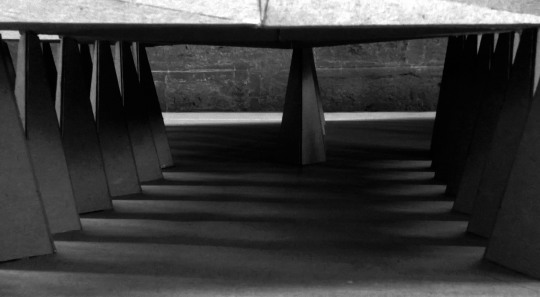
Fig. 3. Physical Model, Structure and Form Workshop – Pavilion for an Exposition
How was teaching at your school?
Teaching at the school was more about discussions and interactions that encouraged students to take positions and express themselves confidently. It was never prescriptive. And there were no written exams. For design reviews, we had discussions on a regular basis. And for theory subjects, there were presentations and written assignments. In the schedule, more time was assigned to design studios. And since CEPT had a 24-hour studio culture, one naturally ended up spending more time on the campus itself, which facilitated peer learning through informal interactions to a great extent. There were also electives offered in every semester besides the core subjects, which allowed us to explore other areas of interest as well. And of course, the CEPT library is something remarkable. One could find almost any book one needed there. Overall, there was a lot of room and resources for learning on your own.
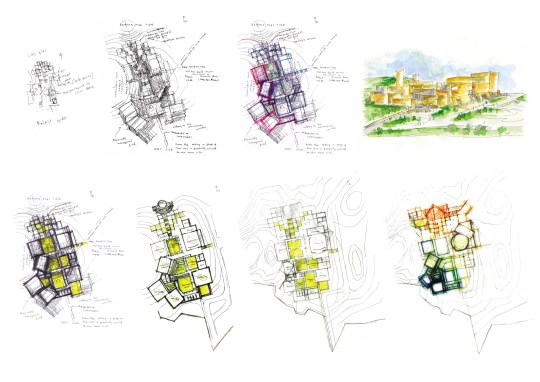
Fig. 4. Design Development Sketches; from the initial thumbnail sketch to the final resolution, Studio Project 2 – Marwar Knowledge Centre, Jodhpur
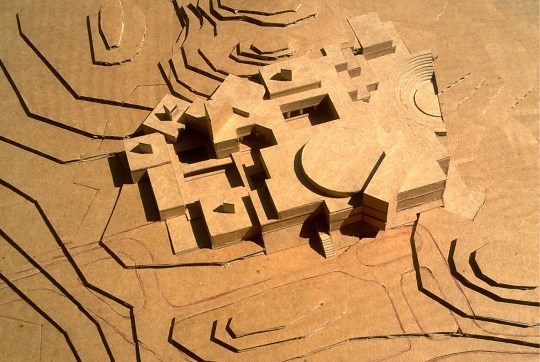
Fig. 5. Physical Model, Studio Project 2 – Marwar Knowledge Centre, Jodhpur
Tell us more about the mentors.
We had really inspiring teachers at CEPT. One could always approach them and even chance encounters on campus could lead to discussions. And in the design studio, I especially had a very memorable experience under Prof. Kulbhushan Jain, who was also our department head. During design discussions, he was a great listener and would give us brief, indirect but very insightful comments on our designs. His teaching method was so subtle that he could make you conscious of your talent or inclination with minimum direct input.
I also had a great time doing my thesis under Prof. Meghal Arya’s guidance. We had discussions on a weekly basis, and she would set smaller deadlines for every meeting. She was very persistent in making me completely occupied with the study. And it really helped in structuring the whole study into a tangible form on time.
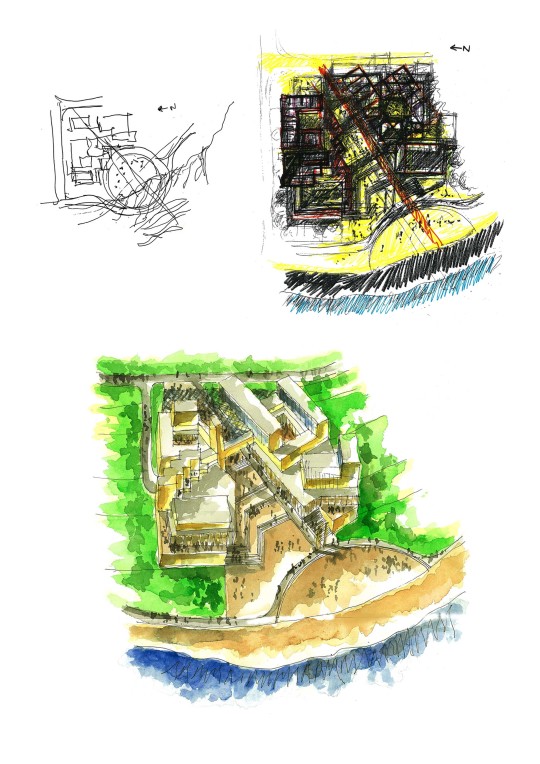
Fig. 6. Conceptual Sketches, Studio Project 3 – Institute for Nature, Bhopal

Fig. 7. Physical Model, Studio Project 3 – Institute for Nature, Bhopal
Could you tell us what your thesis was about?
I was very interested in organically grown traditional building complexes. Such complexes developed incrementally over centuries, be it the Alhambra in Granada or Katsura Palace in Japan or Mehrangarh Fort in Jodhpur. Their plans, as we see them today, were never preconceived. They were allowed to unfold gradually with time. And that could be the reason for the ‘wholeness’ or ‘harmony’ that we feel in such complexes. So as an architect, I wanted to know how one can inform one’s design process by studying such complexes. I took Padmanabhapuram Palace in Kerala as my case study, and also decided to use only sketches and drawings throughout the study. I hoped that by sketching the whole thing one could also probably end up having some kind of a tacit understanding of the place. The study made me conscious about the role of organic growth processes in uniting buildings and surroundings.
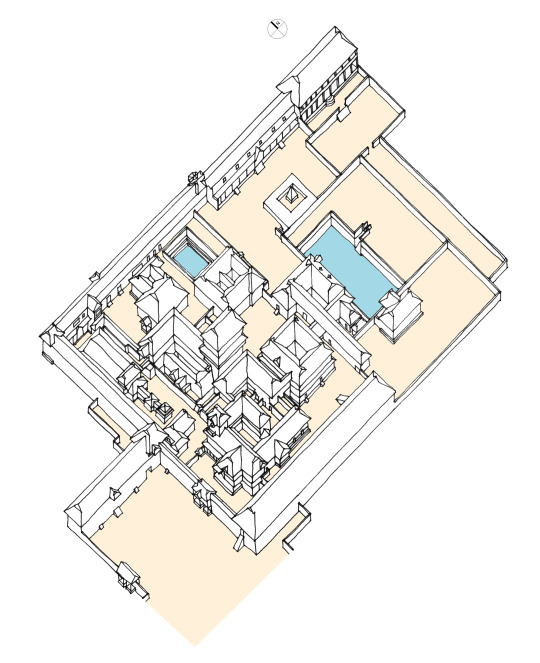
Fig. 8. Padmanabhapuram Palace: Axonometric View, an illustration from the Research Thesis
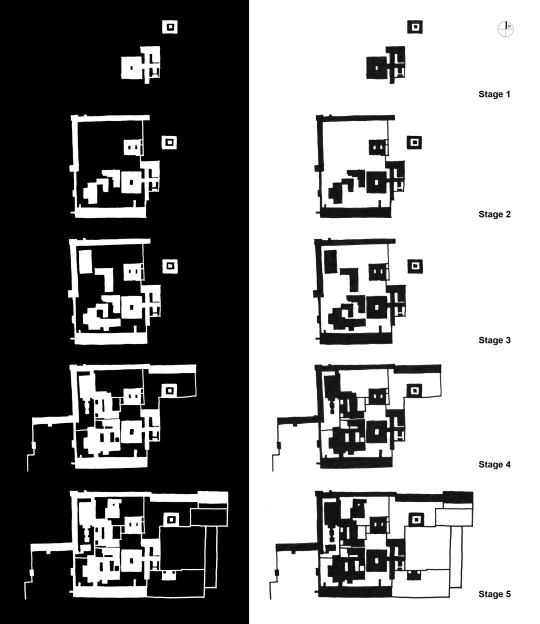
Fig. 9. Padmanabhapuram Palace: Stages of growth of the complex, an illustration from the Research Thesis
How did you manage the finances?
I had to take an educational loan of around 4 Lakh INR towards the tuition fee. And the living expenses were met by the 8000 INR monthly GATE scholarship I would get.
Did you volunteer/work part-time job/intern while studying?
As part of the course, we had to either do a short internship or make a travelogue after the third semester. I chose to work with my previous employer on a competition project during that time. It qualified as an internship and also earned me some income.
How did you choose your accommodation? Did you have to commute to reach lecture halls?
I stayed at the college hostel, which was very close to the campus and an economical option.
How did you manage the finances?
I had to take an educational loan of around 4 Lakh INR towards the tuition fee. And the living expenses were met by the 8000 INR monthly GATE scholarship I would get.
Did you volunteer/work part-time job/intern while studying?
As part of the course, we had to either do a short internship or make a travelogue after the third semester. I chose to work with my previous employer on a competition project during that time. It qualified as an internship and also earned me some income.
How did you choose your accommodation? Did you have to commute to reach lecture halls?
I stayed at the college hostel, which was very close to the campus and an economical option.
Did you travel while/after studying?
The sites allocated to us for studio projects were located in different cities. So as part of the design studios themselves we could travel to different parts of Gujarat, Madhya Pradesh and Rajasthan. And it was a great exposure to work on design projects in different climatic and geographic settings. One realizes that regional architecture is nothing but a direct outcome of how people reacted to the climate and geography of their place. Especially the experience of Mehrangarh Fort in Jodhpur was really moving. It was something completely different from the kind of tropical buildings in Kerala I was familiar with.
Are there any notable anecdotes from post-grad studies that you wish to share?
Prof. B. V. Doshi once came to our studio for a design review. It was a much anticipated review and we were all very keen to present our work before him. After the review, someone in the class asked him if he could make a sketch for the whole class and he agreed to do so. And we were all so excited to see Prof. Doshi sketch; such expressive lines drawn with a childlike playfulness!
I also have a vivid memory of the day Charles Correa came for a lecture at CEPT. The whole campus was fully packed even two hours before his lecture started. The atmosphere was exhilarating. For me, personally, it was an exciting thing to see him present his work, for I have been an ardent admirer of his work from my undergraduate days. The utmost clarity with which he could articulate his ideas and his sharp wit made my appreciation for his work even more pronounced.
How do you think doing a master’s degree helped you?
I think the exposure really helped me build confidence and opened me up in many ways. Most importantly, the course made me conscious of different synthesising processes, than just approaching the design in a purely functional and problem-solving manner. One started to believe in the initial intuitive or gut responses; the immeasurable aspects of design process which begin much before conceptualisation.
Recently I got a chance to try out some of the themes I was pursuing during the master’s, when I was asked to associate with NMS Architects to participate in the invited competition for IIT Palakkad Campus. Even though we could only reach up to the financial bid stage of the competition, conceptualising a project of this scale and complexity in a very short time was a real test for my capacity for synthesis. The concept of the main academic complex was inspired from the organically grown Indian Palace Complexes, keeping in mind the incremental growth of the campus. Unlike the conventional campuses, the individual disciplines were grouped as a tightly packed building complex, ensuring mutual shading of the buildings and creating climate tempered in-between spaces for activities to spill over. And we hoped this network of shaded courtyards and pavilions connecting different disciplines will also encourage chance interaction between students and will create a milieu of interdisciplinary interaction and informal learning.
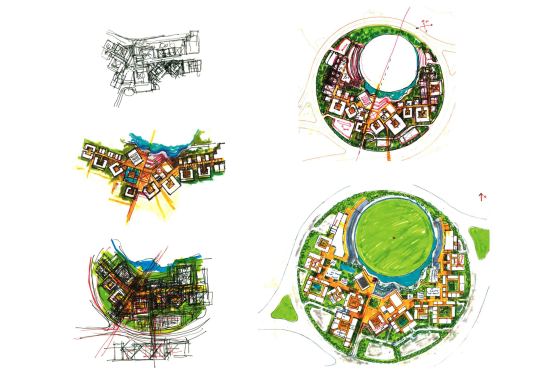
Fig. 10. Design Development Sketches, The main academic complex, Competition Entry for Indian Institute of Technology, Palakkad (Associated to NMS Architects)
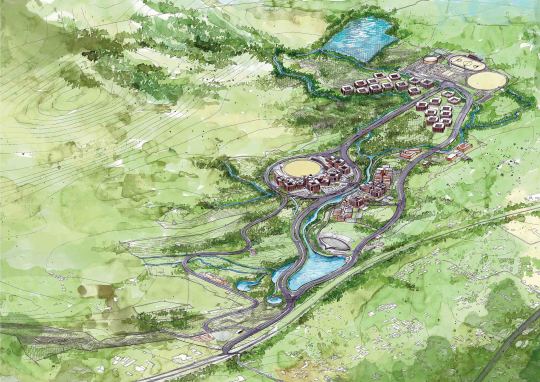
Fig. 11. Bird’s Eye View of the overall Master Plan, Competition Entry for Indian Institute of Technology, Palakkad (Associated to NMS Architects)
Currently, I am really excited to be part of Prof. Kulbhushan Jain's new book on architectural education titled 'Learning Architecture'. The book is basically a collection of fifteen essays by young educators from different parts of India, edited and with an introductory essay by Prof. Jain. So, I think doing master’s degree opened up new avenues for me; organically leading to many opportunities, through the friends I made or through the goodwill of the very fine teachers I learned from.
Did the city/country you studied in play a major role during your postgraduate study?
In Ahmedabad, the presence of works by many master architects and also the rich traditional architecture left a great impression on me. During my two years at CEPT, I visited the works of Claude Batley, Le Corbusier, Louis Kahn’s IIM and works by B.V. Doshi and Charles Correa. I was also impressed by the simplicity of projects by Prof. Neelkanth Chhaya and architect Leo Pereira. And I was really moved by the profound simplicity of Gandhi’s home at Sabarmati Ashram.
Could you please tell us about your current work and future plans?
Currently, I am operating as a one-man practice and also teach design part-time. I am equally interested in farming and am trying to incrementally develop our place in Calicut into a house, studio and garden, where I hope to equally divide my time between designing, reading, writing, sculpting and farming.
What message would you like to give to those planning to take up your program in your school?
In Vitruvius’s ‘The Ten Books on Architecture’ the first chapter talks about ‘Education of the Architect’. When I came across that, I was fascinated by his opening passage on ‘Theory and Practice’. For me the course ‘Theory and Design’ almost resonated with Vitruvius’s advice, who wrote: “…It follows, therefore, that architects who have aimed at acquiring manual skill without scholarship have never been able to reach a position of authority to correspond to their pains, while those who relied only upon theories and scholarship were obviously hunting the shadow, not the substance. But those who have a thorough knowledge of both, like men armed at all points, have the sooner attained their object and carried authority with them…”
About the interviewee...
Ajay graduated from College of Engineering Trivandrum and completed his post-graduation in Theory and Design with top honours from CEPT University, Ahmedabad. His practice Thinking Dwelling Studio revolves around a passionate desire to make architecture that unfolds in time in a manner that draws upon history. His master’s thesis on Padmanabhapuram Palace explored his interest in the nature of ‘unfolding’ and also won him a commendation at the Indian Institute of Architects’ National Awards. Ajay has a keen interest in the architecture of the past and considers research and pedagogy as a means to nourish his practice. Apart from architecture, his interests include literature, sculpting and farming. You can follow his work on Instagram and Facebook:
https://www.instagram.com/ajayjacobk/?hl=en https://www.facebook.com/Thinking-Dwelling-Studio-680062388788126/
#archiecture#Architects#architecturestudent#master of architecture#CEPT#ahmedabad#india#whatafterbarch#higherstudies#bvdoshi#charlescorrea#mastersdegree#educationinindia
0 notes
Text
Interview series - What after B.Arch? #15
Interviewee: Ar. Bulbul Vyas
Post-graduation: Master of Architecture (Major in Urban Design Minor in Conservation) | Centre for Environmental Planning and Technology University, Ahmedabad, India
What prompted you to take up this program?
During my undergraduate program in Architecture at CEPT, I developed an interest in understanding city processes that affect the built environment. The question of expanding and positioning the role of architecture in the making of cities would always be running at the back of my mind. After completing my undergraduate degree, I had a muddy idea of the kind of processes I would like to engage with and I had a fairly clear idea that the answer is in further education. So, I began looking for options for a master's program that would allow me to explore different aspects of the built environment. I zeroed down on the M.Arch course at CEPT as the University was setting up a new program that year which would allow one to pick a major and minor subject from the disciplines of Urban Design, Conservation, Architecture Design and History and Theory. It also allowed one to pick electives from a larger pool of options ranging from architecture to planning to interior design. I finally graduated with an M.Arch - Major in Urban Design and Minor in Conservation and I took all my electives from History Theory and Planning.
When did you take up Masters?
By the time I had completed my undergraduate degree I had already completed three internships each spanning six months. First was the mandated seventh semester internship, the next was an opportunity to intern at Renzo Piano Building Workshop at Paris in exchange of an exchange semester and the last was an internship alongside my undergrad research thesis. CEPT in those times had a thorough process of approving the research thesis which would usually take up to three months to set up the final viva date from the date of the submission. The day of one's viva is considered as the official graduation date since the day of conferring the degree is an annual event. In my case, I had about one year between the day I handed in my thesis and the day of Convocation. So, I had plenty of time to mull over my options. Meanwhile, I also assisted a master's studio and travelled a bit. By this time, I had travelled a fair bit in Europe and India and I knew that I wanted to work/teach in India and grow my understanding of the Indian context and so it made sense to take up a Master's program in India. I started preparing for the Master's program about six months after handing in my undergraduate. I took up Master's because I had enough time and exposure to think about this being the right step for me at the time. I feel it is important to take the time to decide how you would like to position yourself in the professional/academic world and really think about the kind of processes/engagements that, for you, would sustain and develop a fulfilling interest in the long run. If Master's is an enriching step in the process, then one should do it. Or take whatever step that would help you grow in the direction of your interests.
When did you start with the application process considering the time for application, scholarship deadlines?
I started my application process two months before the deadline. I started working on my portfolio at the same time. I did not qualify for any scholarships, so I didn't have to think about that.
What preparation did you do before starting Masters?
I started working on my c.v. and portfolio and this helped me to mentally organize my interests and do a retroactive summary of my experiences. I also wrote a motivation letter for taking up the Masters as an exercise to see whether it was the right decision. I think externalizing one's motivations in a structured manner is a great help in decision making. This really helped my prep for the interview.
I spoke to some of my professors who were also teaching in the Master's program to discuss and check my expectations from the program and to know how a Master's program is different from an undergrad program and whether or not it was the right time to do it.
Did you have to give any entrance tests? How did you plan for them?
No. It was a two-part interview with portfolio. Each was a panel of three professors/ program heads. My answer to the above question already answers the question about planning for the interview.
How long was your program?
The program was two years - four semesters. The first semester was a common foundation course for all the four specializations. It was a monsoon semester start. It ended with a spring semester. The last semester had a placement interview from big MNCs but was mostly run by an HR team and wasn't very appealing.
Did you have post-masters plans in mind when you took up Masters? Or did you go with the flow?
I wanted to take six months off after my Master's to work more on my Master's research thesis as I wanted to make it publish-worthy but I got an equally interesting job opportunity and I took that up instead.
How was the experience at the school?
I was right at home since I did my undergrads here too.
How was teaching at your school?
There were studio slots, mandatory classes and electives. There was enough time to focus on Studios which were pretty intense. Mandatory and Electives were less in number but equally intense in engagement. For most mandatory and electives, one had to come prepared with readings beforehand or there would be weekly exercises. Most submissions were online and deadlines were non-negotiable.
The courses were intense and involved a lot of group work but with proper time management one could find time to do other things.
Tell us more about the mentors.
Mentors were very thorough and passionate about the subjects they taught. They had a lot of in-depth knowledge and were often experts in the subjects they taught. It was easy to approach them on campus, but one could also schedule a meeting for longer talks.
Were you involved in research projects/competitions while studying?
Other than the Master's research thesis, no.
Could you tell us in brief what your thesis was about?
Final thesis was a semester long. It could be a design thesis, a research thesis or an advocacy thesis. There were mandatory classes on research methodology for all the students in their thesis semester. Apart from that one had to choose a thesis guide before the proposal submission which was one month into the semester. I approached my thesis guide well before the proposal submission with a rough idea about the research I want to pursue. I developed the proposal drafts and had regular meetings to discuss the progress on the proposal and to understand the methodology and framework for carrying out the research and the timeframe and selection of case studies. The program had a planned schedule of meetings with the thesis co-ordinator to check on the progress and an internal review panel was set up for each student consisting of three members that would meet at three stages during the entire semester - Proposal submission, Data gathering and Analysis and Final findings and conclusions. Then there was a final external jury to whom you had to make a presentation. The external jury did not have time to go through your thesis beforehand and so the assessment relied heavily on your presentation that day.
How did you manage the finances?
My parents sponsored my education.
Did you volunteer/work part-time job/intern while studying?
No
Could you tell us about your accommodation during the study?
My parents own a small studio apartment in the city which I have been staying at since my undergraduate days.
Did you travel while/after studying?
I would travel in summer breaks within India. To parts that I hadn't visited before or just batch trips.
How do you think doing a master’s degree helped?
This Master's degree helped me think more critically about my position in the field of Architecture, Urban Design and Conservation. It made me more aware of the impact of my actions as a professional who deals with the physical aspects of the built environment. It helped me situate my role and contribution to the field and frame my future response.
Did the city/country you studied in play a major role during your postgraduate study?
Since I knew I wanted to contribute to knowledge production on Urbanism in India, the context most definitely mattered as I got exposed to work and research by Indian scholars on the subject. It also exposed me to various paradoxes that exist within the field and helped me situate myself more critically in the context.
Could you please tell us about your current work and future plans?
In the past few years, I have worked in the capacity of an Architect, Urban Designer and Researcher at Banduksmith Studio in Ahmedabad and I continue to contribute to government public projects that the firm is working on. I was also engaged in teaching activity at CEPT University for studios and electives pertaining to my interest in Urbanism. Currently, I'm taking a sabbatical to do a one-year Advanced Master in Cultural Anthropology and Development Studies at KU Leuven, Belgium starting this September.
What message would you like to give to those planning their post-graduate studies?
Take up post-graduate studies if you think it will help you grow personally, and you are motivated enough to study more.
About the interviewee…
Bulbul Vyas is an architect and urban designer from CEPT University, Ahmedabad. Her interests lie in understanding the contribution of informal processes of urbanization to the formation of public space in Indian cities, and their potential to inform the formal processes of city design. She engages with this premise through practice and academics; working on urban projects and research at BandukSmith Studio and through academic engagements at CEPT University





All images courtesy of the interviewee.
#architecture#architect#architecturestudents#higherstudies#centre for environmental planning and technology university#cept#ahemadabad#india#whatafterbarch#master of architecture
0 notes
Text
Interview series - What after B.Arch? #14
Interviewee: Ar. Gaurav Goel
Post-graduation: Master in Digital Architecture and Tectonics | University of Nottingham, United Kingdom
What prompted you to take up this particular program? What about the school/program appealed to you?
During My Architecture graduation in India, I was always inspired by the new face of international architecture. I was always curious about how modern architecture is being shaped today and what technologies architects are using for architectural design research in their studios. It was evident that training in technology for new architectural thinking cannot be avoided for the future discourse of Architectural practice. So, with all these curiosities I listed out universities that aligned my research interests in Architecture. Eventually, the University of Nottingham offered an intensive program for M.Arch in Architecture Technology (Title Currently modified to Masters in Digital Architecture and Tectonics), which aligned to my interests for higher education in Architecture. The course content, faculty, University ranking for research output, its campus, previous work from student’s handbook and international competitions appealed to me in selecting this program. Nottingham University also offered a chance for a scholarship to students from Commonwealth countries, which was a sigh of relief from expensive education tuition fee in England.

When did you take up Masters?
I took a break for two years after my bachelor’s in India because sometimes the Academic specialisation we aspire to gain does not work in an architectural ecosystem present in our country due to various constraints. Therefore, it was a wise decision to analyse current design trends and the need for specific knowledge required in the domain of current Architecture in India. The break from academics also provided me with some time to travel and reflect on my experience of architecture acquired over the years. During this time, I interned with an architectural firm handling Airport and University designs for Indian government. I was also handling some independent architectural projects to gain insights into the challenges of working as an independent Architect in India. Along with this, I used this time to attend a summer school with Architectural Association London and learned their novel computational techniques for producing new architectural spaces. That was a huge influence on my Masters in Architecture. Due to the reasons stated above, I would recommend all future students to take a break from academics before masters unless you get some exceptional opportunity right after your graduation.
When did you start with the application process considering the time for application, scholarship/bursary deadlines, etc.?
I started the application process around 6 months before. It was a long process because I wanted to apply for scholarship also. I did not want to rush and therefore I arranged recommendation letters, prepared an exclusive portfolio, wrote an essay for the scholarship with much time and attention. It also allows the university to assess your work better if you apply early to these programs.
What preparation did you do before starting Masters?
Getting into a higher university abroad can be pretty daunting. I was paranoid about a lot of stuff related to academics, different culture and place. For academics, I studied the course content beforehand and did some reading to acquire a glimpse of the topics I was about to study. But in Architecture its more about the studio exercises, so I tried to explore how design studios and architectural discourse works in England. Many online resources, student videos, and previous student architectural projects helped me clear out my doubts. Other than this, social media groups from the university, some seniors from the course and university student support prepared me in advance to deal with the cultural shock. The first induction week at Nottingham University was amazing. There were student mentors who showed us around, along with some conferences and lectures about working at Nottingham University. I made some of the best friends that week. I would strongly recommend attending induction week before any masters as it will act as a catalyst to adjust you into a new environment and engrain you into the student fabric of a particular university.

Did you have to give any entrance tests? How did you plan for them?
Yes, I appeared for an IELTS exam scoring a 7.5 to make my visa application stronger. But at Nottingham University I was not required to appear for a Language proficiency test because I scored above 90 per cent Marks in English for my CBSE 12th-grade exam in India.
How long was your program?
Masters in Digital Architecture and tectonics at Nottingham University is an intensive 1-year program including 3 months of dedicated research writing of about 30000 words. This program starts in September every year and finishes after 12 months. After the course duration, University runs student competitions and organise a year-end show that is attended by experts in Architecture from England. This is the best time to showcase your work and catch the eye of an architect aligning your interest. There were not many direct job opportunities through university, but those year-end shows helped me to grab some job offers from current architects who saw my work.

Did you have post-masters plans in mind when you took up masters? Or did you go with the flow?
I was very clear about my future plans after Architectural masters. I wanted to come back to my country after completing my research and contribute to the academic and real architecture domain of the Indian market. India is progressing nation and specific clients and organisations want to experiment and invest in modern architecture. Therefore, I have a keen interest to practise Architecture in India using local resources and my specialised skills.
Did you have to apply for a visa?
My visa process was very smooth. I applied it myself with the help of the Embassy website. All documents required were listed on the website clearly along with the procedure. After my CAS letter the visa process took around a month and I was granted a student visa for a year along with an additional 6 months of post-study work in the UK.
How was the experience at the school?
Architecture department of Nottingham University is a highly respected institution in the UK. It has one of the best research output and infrastructures along with state-of-the-art labs with 3D printing, vacuum forming, CNC machines, Digital 3d scanners and carpentry tools. I had an intensely immersive and international experience at this University. By international I mean there were students from every nationality and they brought in their cultural views into design studios along with expert international mentors. Other than this for the first time in my life I studied architectural research methods, which opened my eyes towards researching in Architectural field in a planned fashion. It was a big surprise for me to learn that there is so much that could be researched and written about Architecture. There was a strong culture of collaboration for inter-departmental research. For example, if we are designing a building façade, we can involve the mechanical department for its physical development and details. That helped us in understanding architecture as a collaborative process, which is vital to practise in the current realm.
Moreover, there was a planned schedule of the program that we followed the whole year. At the start of the course we knew the exact date when we will have our last lecture and submission, a crisp academic plan like that provided us with a clear path of studies. University also provided lectures by an industry leader on current developments in the latest building trends. It provided an exposure that was difficult to gain elsewhere. Along with this, they had field trips which were great in understanding realities of complex forms and their fabrication pedagogy to instil our interest in computational design. Finally, a big opportunity I got was to involve myself in clubs and knowing likeminded people from around the world. I was a member of Architects society, gliding and kayaking club. I used to attend architect socials, fly gliders every month for our training along with kayaking lessons from experts. These clubs helped me to enhance my experience at the university. Overall my experience at school of architecture was very rewarding and fruitful in terms of knowledge and skills I gained during my academic discourse.

Tell us more about the mentors.
Mentors at Nottingham University are very professional in terms of mentoring students. It was exciting to know about their research and work in the field of architecture. Every mentor was very responsive on emails and I never faced problems meeting with them. They were very supporting and always open for informal discussions too. Some of the professors used to invite students for dinners also at their house. Moreover, Professors always used their industry contacts to introduce us to experts with our research interests.
Eventually, all my professors had an impact on my learning as an architect but few of them motivated me personally. I was very influenced by the work and guidance of Dr John Chilton who is an expert in shell structures and has written many international publications on this subject. Along with this Dr. Paolo Beccarelli who is a leading expert on fabric and tensile structures influenced me to research my master’s dissertation on tensile structures. I was also inspired by the research work and knowledge of Dr Philip Olfield who was the mentor of Tall Buildings studio. He is currently an active member of the Chicago-based Council on Tall Buildings and Urban Habitat (CTBUH). Lastly, I would like to mention my studio mentor Tom Bennett who is an expert in computational design. He was part of the design team for winning proposal of UK pavilion for Milan expo 2015. He was seminal in introducing me to computational design and programming. Currently, he works with a collaborative design practice called Studio Bark in East London.
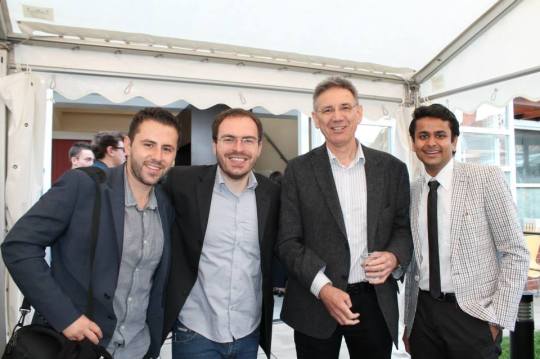
What kind of support system did your institute/university have in place for international students considering a different learning environment from that of Bachelors?
International students at university are supported by the International student office at Nottingham University. They are dedicated to helping you deal with the new environment, emotional concerns along with academic hurdles you face during your studies at the university.
Were you involved in research projects/competitions while studying?
Yes, during our course we participated in national conferences, research projects of our faculty members and architectural design competitions. Along with my Mexican colleague, I won an Architectural award from Benoy Architects London for our project “UK Pavilion- Milan expo 2015”. This project was displayed at the end of the year show along with RIBA exhibition in England.
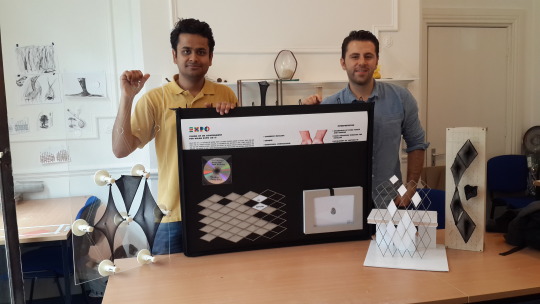
Could you tell us in brief about your dissertation?
My masters concluded with my dissertation research under Dr John Chilton and Dr Paolo Beccarelli. It was titled "INVESTIGATING THE ROLE OF COMPUTER SOFTWARE FOR CONCEPT DESIGN OF TENSILE MEMBRANES IN ARCHITECTURE: A COMPARISON OF PHYSICAL AND DIGITAL MODELLING PROCESS”. This research was awarded merit marks along with appreciation from the industry. Through this research, I investigated how form active structures are being designed using computational power in the current era.
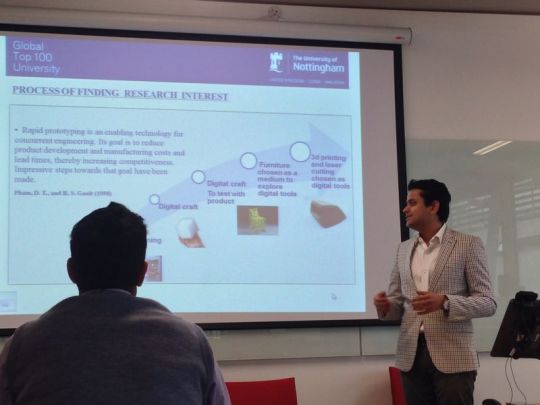
Tell us about the process.
I had a discussion with my supervisor while we were on a field trip to Milan. Our informal discussion helped me understand my topic and methodology that I needed to write a dissertation. Along with formal supervisor meetings, the University of Nottingham organised workshops to demonstrate how to write academic research. These workshops were highly professional and helped me in writing quality research.
We had a clear time table defined from the start of the research. There was a fixed number of times we were supposed to report our progress to the supervisors, but they were always available on mail to answer any queries. My initial meetings with my supervisor were long and intense as they laid the foundation of my research. I used to mail the work before meetings and my supervisor examined and gave his feedback during the office discussions.
There were several challenges during the research. The main challenge was time. In just 4 months we had to write 30000 words for our dissertation. Along with this my first-hand exposure to academic research posed me a problem of setting research goals. It was very tough to organise a vast amount of reading data and experiments into functional research that imparts a meaning to the profession. One of the other challenges was reading, while in India I never read a lot. But during dissertation library was a second home and they had all the academic resources available in the world to support our research material at the Library in Nottingham University.
We had a final presentation before final dissertation writing to include expert feedback into our research. That was followed by intense weeks of writing and submitting our dissertation to the university department as per the deadlines.

How did you manage the finances?
For my masters, I had a scholarship for 50 per cent of tuition fees. Rest of the expenses of academics and living were covered with the help of my parents. A restricted amount of travelling, self-cooking and budget accommodations were some of the things that helped me to cut down my expenses.
Did you volunteer/work part-time job/intern while studying?
No.
How did you choose your accommodation? Did you have to commute to reach lecture halls?
I took an off-campus accommodation at the university. It allowed me some flexibility in terms of living. It was a large house shared by other students with common amenities. It was nearby university and cheaper than university accommodation.
Did you travel while/after studying?
Yes, during studies, we travelled to many cities as part of architectural field trips in the UK. I covered many British towns along with a Europe trip with international student travel society. All my travel was motivated by curiosity to witness architecture and experience new places. During my travel, I visited some of the architectural marvels in Europe and the UK.
Are there any notable incidents/ anecdotes from post-grad studies that you wish to share?
There are many incidents to share, but one particular I would like to mention. When I started my course at university during initial lectures, I was very participative in studio and interactive with faculty members. So, one evening after my lecture one of my Latin and Chinese friend asked me how come you speak such good English, does India have such a good education in English. I was amazed by the imagery of India in their mind and I laughed and said that in India most of us learn English from kindergarten itself. I told them to read about India and its current development. It is no longer a land of snake charmers only.
How do you think doing a master’s degree helped you?
My master’s degree enriched my career in multiple perspectives. The first and most important thing I gained from my masters was an international exposure in the field of design. It gave me multiple skills to be a part of an international community of design professionals. I presented my designs among a group of international design jurors and participated in design competitions. It gave me courage and confidence as a professional to practise architecture anywhere around the world. Another aspect of international university was learning to work in a team with people from different ideologies and culture. I learned how to embrace these ideas and keep your mind open towards novel thinking, which is vital in the Architectural profession. Due to my masters, I gained the ability to think critically and holistically about architecture. I learned how to discuss and debate ideas academically in intensive studio exercises with experts, how to navigate existing research and most importantly how to research your own ideas using the existing academic resources. At Nottingham university, I was constantly challenged in terms of my ability as an architect and they always guided me professionally to overcome those challenges without spoon feeding. In all, it was worth pursuing masters at the university of Nottingham to explore and equip myself with skills that are helping me in my career as an Architect.
Did the city/country you studied in play a major role during your postgraduate study?
Nottingham as a town is full of history and enriching past in terms of architecture. During my time at Nottingham university, I had a chance to experience this town as a resident. And due to this, I had a significant impact on my design education. I became more sensitive to history, context and climate while designing buildings. Also, public spaces and urban infrastructure is very impressive in England. It gave me an insight into how the quality of urban architecture can influence a citizen’s experience within an urban community. Eventually, I tried to incorporate all these learning into my designs while PG.
Could you please tell us about your current work and future plans?
After returning from the UK my research interest in computational design lead to the creation of an educational blog called PARAMETRIC CURIOSITY. Over the course of years, it has become a community of people from all around the world to witness and talk about computational trends in architecture and design industry. Our current Facebook blog has more than 4600 followers who are engaged in an active community of architects and engineers interested in computational and digital architecture. Eventually, I launched Studio Parametric Curiosity India inspired from my blog’s success, it is an Architectural practice headed by me. We are Involved in developing a sensible urban built fabric by designing multiple architectural projects ranging from residences, commercial, recreational architecture and interiors in Delhi and NCR. Our recent projects include a ceiling Installation in Kenya, a sustainable eco-house in Delhi, a Hotel in Lansdowne along with other building projects. Most of our work stresses upon User functionality, architectural sustainability and integration of computational techniques during the design process.
What message would you like to give to students/professionals planning to take up your program in your school?
For all the prospective students who want to pursue higher education in Architecture, I would like to advise for deep self-introspection for the reason of higher education. Eventually, decide your passion and interest in the current architectural profession to specialise in. Thereafter, find a university that has most research output, facilities and association with experts in the field you want to pursue a master. University is all about soaking the best academics available in the field you want to specialise. One should assess their opportunities carefully and analyse the impact of their education in the future architectural practice.
Looking back, was there anything you would have done differently?
International university education is appealing. New places, people and academic environment all fills you with great spirit and zeal. I would like to warn students to not get carried away from all the new changes that come in your life as a student. Remember your main goal of education and take your academics seriously. All the universities abroad are very serious with quality and timely submission of your assignments along with your performance. Make sure you take full support of university facilities and faculty to get across your academic challenges.
ABOUT THE INTERVIEWEE:
Ar. Gaurav Goel holds a master's degree in architecture from the University of Nottingham, and a master's diploma in parametric design from Spain. He is a gold medallist in B.Arch. from Amity University. Goel founded Parametric Curiosity in 2016, an architecture studio and a social media blog for sharing digital explorations in the field of parametric design. Besides, he has attended many international workshops such as Summer School with Architectural Association - London and Master in Parametric Design at Control Mad - Spain to learn nuances of algorithmic design processes. Goel’s research interests lie in form finding, temporary and permanent pavilion installations, form optimisation, digital fabrication with CNC, 3D printing, architectural façades and other geometrical explorations using computational tools such as Rhinoceros and Grasshopper 3D. His studio's latest projects include a ceiling installation in Kenya, a hotel in Lansdowne, a holiday home in Uttarakhand and a sustainable eco houses in Delhi and Gurgaon.
You can reach him at their Facebook, Instagram and YouTube channel called Parametric Curiosity. For more details about his work and him as a professional visit his LinkedIn account.
#Architecture#architect#architecturestudents#postgraduation#higherstudies#mastersdegree#the united kingdom#nottingham#universityofnottingham#whatafterbarch
0 notes
Text
Interview series - What after B.Arch? #13
Interviewee: Ar. Aditi Pai
Post-graduation: Master of Landscape Architecture | CEPT University, Ahmedabad, India
What prompted you to take up this particular program?
I realised in due course of the architectural educational journey that the built spaces cannot and should not be isolated from its surroundings. The response to site context is very important and it would be with the help of further education in Landscape Architecture that I could strengthen my understanding in this regard.
I focused on schools in India to study Landscape Architecture since it would help me be relevant and allow me the time to absorb the nuances since I had already planned to set-up my own practice here.
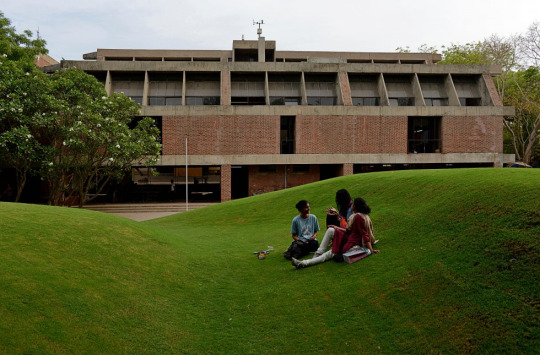
Image source: https://cept.ac.in/441/cept-university
When did you take up Master’s?
I practised at Integrated Design (InDe) in Bangalore for nearly a year and a half (Including my Internship) before taking up Masters. While I was sure about my interest in landscape architecture, my short stint at a firm that practised Landscape helped me in getting clarity regarding the field. This helped me be sure about why I was studying the course, opened me up on a lot of technical aspects that I was expecting to learn more about and also to be open to all that the course had to offer.
This can be taken up in two ways, the first would be to continue with the flow of education after Bachelors to avoid a break in the professional world once started or another way would be to work for a bit (Ideally in an office that already practices the Masters subject one is looking at - Urban Design, Landscape etc) and be ready put in that extra effort to make up for the break and get back on track with the practice at the earliest.
When did you start with the application process?
It is always good to keep track of the applications processes followed by the institutes one is interested in and send applications on time to avoid last-minute hustles! I can’t remember the dates, but I was well in time with the application process.
What preparation did you do before starting Master’s?
My work experience at Integrated design (InDe) under the guidance of Landscape Architect Mohan Rao, has been my foundation into understanding the profession in its best form. This practical understanding of the subject was my preparation for the Masters Programme.
Did you have to give any entrance tests?
The selection process was in three stages:
Portfolio of works that was to be mailed
The selected students had a written test based on general knowledge regarding Landscape and
A personal interview with a panel of interviewers.
How long was your program?
2 years. From July 2009 to July 2011
Did you have post-masters plans in mind when you took up Master’s?
Yes. I had already planned to have my own practice focusing on Architecture & Landscape design. That helped me to always be aware of both built & unbuilt spaces while studying the subject to plan the way ahead
Could you tell us a bit about the learning environment at CEPT?
The teaching process at CEPT is very informal. The lectures are more like discussions which makes it very interesting. The exercises involved some individual projects and a lot of group work as well. Most of the exercises required us to work on real sites from around the city and designing solutions for them. (Which also helped us explore the beautiful city of Ahmedabad)
The faculty had been very approachable at all times. CEPT, as a campus has such a strong sense of space and an aura of the Master architects that can be felt in every space. This encouraged interactive learning from peers and faculty through discussions (from the course and other disciplines as well) throughout the campus. So once you are in CEPT, the learning is always on and it is best not to shut-off because 2 years is all that one has there.
Studying at CEPT from 2009 to 2011, gave me this opportunity to study under the guidance of one of the pioneers in the field of Landscape Architect in independent India, Prof.Prabhakar Bhagwat. It was extremely inspiring to see the passion for landscape in him and being so actively involved with all the works happening at the studio and having nearly 60 years of teaching and practising experience in the discipline!
Also, the entire design faculty were well established Landscape Architects like Ar. Aniket Bhagwat and many others. The course also involved interactions with practising consultants for all the technical subjects which made the learning very practical.
Were you involved in research projects/competitions while studying?
Yes. The studio works were predominantly research-based scaling from small projects within the city to larger scale regional studies.
Could you tell us a bit about your thesis?
We were encouraged to consider thesis topics in or closer to our home towns to make the research possible in a more familiar environment. My thesis was about studying the Environmental impacts of recreational activities along the banks of River Kali. The process, in a nutshell, involved us to visit the site and gather all relevant data to get acquainted with the environment. Post that, it was through continuous discussions with the faculty that we analysed all the data, explored further through rigorous reading and generated a well-researched document that becomes a resource.
How did you manage the finances?
Since I couldn’t get scholarships, my parents helped me with the expenses along with a little of my savings that I managed to gather while I was working before pursuing a Master’s.
Did you travel while/after studying?
Travelling during the course was more to explore the architecture and landscape around the city. As part of the course, the travel was mainly for Thesis work and summer internship. Also, through a subject called regional study, we analysed a small city called Shirpur in Maharashtra which required us to spend a lot of time on site generating data for the research.
How do you think doing a Master’s degree helped you?
I believe Master’s should only be considered if one really finds the need and is not a compulsion. Since I was already planning on the studio, my purpose of pursuing Masters was to bring in added value to the studio and practice a good blend of built and unbuilt spaces with an evolved response to a context. Working in a firm that practices Landscape before my Masters, gave me the opportunity to interact with a people from the discipline and also from CEPT from whom I could get a know-how regarding the course.
The course by itself touched upon a wide spectrum of Landscape which equipped me with the knowledge to address projects of varied scales and typologies.
Did the city/country you studied in play a major role during your postgraduate study?
Absolutely! Ahmedabad as a culturally rich city and heaven for lovers of Modern Architecture and to be studying in an institute designed by the Pritzker Laureate Prof. B.V Doshi is never short of inspirations.
Could you please tell us about your current work and future plans.
I am the Co-Founder and Principal Landscape Architect at The Purple Ink Studio, a practice co-founded with Akshay Heranjal in 2011 at Bengaluru. The studio believes in constantly exploring the parameters of design and blurring the boundaries between architecture and landscape. Through projects of varied scales and typologies, the studio makes conscious efforts in including landscape as an integral part of the design and endeavours to create micro-ecosystems within the architectural spaces.
What message would you like to give to those planning their post-graduate studies?
Firstly, I would urge the students opting for Master’s (in any subject) to introspect and be sure if the investment of time & resources is going to be worth it since it is a very individualistic choice and (again) Masters is not a compulsion. It is a medium that would bring in added know-how to a subject that the student must be already interested in. Through the seven and half years of running a practising and with several discussions with students, I have observed that the need to study Master’s has become mere fashionable or taken up due to peer pressure than finding the true need and meaning for it.
-------------------------------------------------------------------------------------------
About the interviewee…
Aditi Pai is the Co-Founder and Principal Landscape Architect at The Purple Ink Studio, an award-winning practice co-founded with Akshay Heranjal in 2011 at Bengaluru.
The Studio won the most coveted ‘Best Practice in India of 2016’ award from TRENDS EXCELLENCE AWARDS for Architecture & Design and have also been listed in the PERSPECTIVE 40under40 ASIA and as the Top 50 Next Gen Architects who will shape India, amongst other numerous National & International Honors.
Aditi has her Bachelor’s degree from K.L.S. Gogte Institute of Technology, Belgaum and a Master’s Degree in Landscape Studies from CEPT University, Ahmedabad. She is a TEDx speaker and has also presented works at various design related events in India.
#architecture#architecturestudent#Architects#architect#m.arch#B.ARCHITECTURE#b.arch#whatafterbarch#postgraduation#higherstudies#ahmedabad#CEPT#CentreforEnvironmentalPlanningandTechnology#landscape#landscapearchitecture#bvdoshi#india#indianarchitecture#Gujarat
0 notes
Text
Interview series - What after B.arch? #5
Interviewee: Vedalaxmi Naik
Post-graduation: M.Arch in Urban Design | CEPT, Ahmedabad, India
What prompted you to take up M.Arch in Urban Design at CEPT?
It was two things. First being, the moment I had stepped into CEPT during our B.Arch study tours, I felt an ambience I knew I wanted to be a part of, something like a‘Gurukul’ kind of environment back then.
Secondly, it was my field of interest - Urban Design, which grew on me as we took up our planning studio and urban design studio during B.Arch. These studios ignited that first spark of interest. I researched more about it, took it up as an experiment through my thesis as well as pursued work in reputed organisations/NGOs like Urban Design Research Institute (UDRI), Mumbai where I learnt a lot about the practicalities of a field like Urban Design. This exposure along with my spirit of inquiry for the subject, gave me a good base work and perspective. It developed to be my core area of interest and helped make up my mind to take it up as my Master’s course.The deciding factor for the choice of University was the ideologies of CEPT as a school and how it looked into the Indian contexts. The Urban Design course at CEPT as well as other faculties were all focused on Indian living ensuring awareness of global practices, yet always centred around Indian society, systems, practices and culture. This intrigued me best as I have always been curious about what our nation needed -designwise! Hence, it never occurred to me to take up a course abroad and was determined about pursuing it at CEPT University itself. If we pay attention to matters that earn our curiosity, try and enquire, experiment and experience and end up feeling more curious – I think that’s how we figure out our true calling!
What about the university/program appealed to you?
The learning culture and environment … It reflected an essence of the gurukul culture back when we toured it. We saw that the lawns, the canteen, and the sit outs were all equally considered classrooms and it awed me the most. I personally had a great experience being a part of CEPT’s learning culture. It was beyond walls, probably how design schools should be. Moving away from family and cut off from your social circle for those two years seemed like an additive to the experience of it!
The exposure at CEPT has been tremendously influential in grooming my thought process. People from a multitude of arenas have held seminars, workshops, juries, etc and helped not just academic but extra-curricular development on a creative front. It helped in evolving our thought processes to be more conscious and to nurture our creative instincts helping design attempts to be more intentional, aware, feasible yet radical and unique.
How was the experience at the university?
It was great and definitely opened new doors for me. New exposures to varying kinds of courses and workshops and not to forget the wide spectrum of enthusiasts was a thrilling experience. Interacting and experiencing expertise of people from across the globe surely opens up your mind. I sometimes still want to go back and have those intense design / philosophical / life discussions over chais / tiffins or simply over music in studios. Oh yes! Also not to forget, studios of all fields had access to other studios. You could just pop into another studio if the topic interested you and you didn’t need permission to learn more than your chosen fields. I found this really great unlike the typical protocol of Indian education institutions. Also, the studios used to be open 24 X 7 and it was a good thing because you require that kind of time and academic resources for an intense course as Urban Design. Sometimes it did bog us down to not be able to participate in on-campus events unlike your friends from other faculties. Urban Design as a course was pretty intense with design juries itself scheduled at two ends of the week (Mondays and Fridays). The other courses/lectures/electives etc,.took up the rest of the week. This rarely gave us time to do anything else as the rest of the hours, we got busy into team discussions and trying to speed up conclusions and get going for the next jury of the week.
How was the teaching at your university?
It was definitely a lot of discussion sessions. Our course ensured emphasis on a panel of jurors from varying backgrounds like environmentalists, conservationists, journalists, artists, researchers and eminent architects from other cities and countries. This enabled us to argue and ponder over matters that may not be directly related to what we had done, to firstly be able to comprehend and then debate the repercussions our design may have on these varying fields, directly or indirectly. I am lucky to have shared discussions with some eminent minds like Prof. Neelkanth Chaya, Prof. Yatin Pandya and Prof. Riyaz Tayyabji to name a few. It was these people who kept us at the edge in our design quests.
A lot of group works and presentations involving a lot of library time in studio free hours helped us to explore beyond academics and faculties. The CEPT Library was my favourite, with access to genuine research works and a treasure telling tales of Indian cities.
Tell us more about the mentors.
The mentors we had were from a diverse range of expertise and specialisation. The experiences they shared, varying approaches to the same design enquiries, styles of imparting knowledge across the table, did do us a lot of opening up of our minds. Besides studio hours, they have been more than approachable. Some were always there even for midnight discussions with a cup of Chai. Design schools need such informal interactions in order to exchange ideas, sometimes question and sometimes develop them to extremes and discover new possibilities. Some mentors even invited us over to their homes for group discussions, etc and they have always been accessible to students. My favourite time again was when all these mentors sat across for juries and you could instantly experience their varying approaches to what you had done. All valuable inputs at once – what a crash course for the brain!
The mentors who took up electives were great in terms of exposing you to new dimensions given the short duration allotted to them within the course.
What lessons/insights did you gain from the experience?
Since I had some practical work experience prior to joining CEPT, I somehow had learnt to try and relate academia to practicality. But yes, CEPT taught me the depths, extents and multi-disciplinary relevance to projects. It definitely made us all leave with a strong quiver of multiple dimensions and approaches to our fields as a profession as well as a discipline. The course developed a deep sense of inquiry, informed design decisions and coming out as responsive and reflective of the world around. My approach has definitely been versatile and clearer ever since.
Which semester did you attend?
It was a two year long course, split in four semesters back then. I guess it now follows the Fall and Spring system as updated recently.
How did you plan the entrance exams?
Oh yes! I did prepare for GATE Exams; missed it by one mark. But no regrets as I still managed a merit seat. To my surprise, there was nothing and literally nothing you could find online or books on it back then. I had a tough time planning out the study matter. But I ensured I gather the past question papers and learnt about the kinds of questions, the ways and lengths you are expected to answer, etc. I also attempted CEED prior to GATE exams and I would say that preparation did help me in the background. There were books available for that too!
How did you manage the finances?
It was totally financed by my mother who believed in me pursuing it more than anything else. I owe a lot to her definitely. Financially, what goes unseen during the course is the expense through the course besides the fees. For people interested in pursuing Master’s, I would like to point out that being in a design field, do ensure financial arrangements for expenses besides the tuition fees on paper. That would include expenses like printing, buying stationary and sheets, copying of entire books, model making materials, etc. The course being so extensive, it requires a lot more expenditure and at least a bi-weekly frequency as your design studios.
Did you work a part-time job while studying?
Well no. I wish I could, but nope! There is no time for anything else in the Urban Design Studio. Infact, it was unsaid yet agreed upon across the university that UD students have no life beyond the studio. We were known to not be proactive about extracurricular activities. I remember how we used to sacrifice lunch hours etc sometimes to just catch a glimpse of workshops, or the popular garbha nights, etc that CEPT had to offer. That’s one thing about the UD course I wish changed. Workshops at CEPT were amazing and so were guest lectures from varying fields. I regret not having utilised these opportunities to full potential only because my course was so rigorous that there was no time for these.
Were you involved in research work/competitions while studying?
Yes and No. The research was at a personal level. I would say my thesis was a result of it and I am still looking to take it forward. Competitions were a strict no-no given the exhaustive course Urban Design had to offer.
Did you travel while/after studying? (Ex: Where? For what purpose? How did it help you?)
Yes, I did. We were a group of friends who loved impromptu outings with our DSLRs and sketchbooks. We called ourselves ‘the joyriders’ (giggles). We went around the city and sometimes beyond. It kind of broadened our design abilities as they lead to quite a many discussions/arguments, relating to what we were doing and reflecting on insights.
Could you tell us in brief what your thesis was about?
My M.Arch thesis was my quest for informal spaces, especially in an Indian context – informal street vending in particular. It was about seeking a balance in urbanising cities and yet maintaining the inherent beauty of street vending in an Indian context. The National Law for Street Vendors had just been passed then and my thesis was an exploration of whether this is what Indian streets really needed! A lot of inquiries on the “Indian”ness of spaces in our public places kept me on the thinking edge. The Dadar Flower Market, Mumbai was my site of interest where I visited quite often during my thesis semester trying to understand the nitty-gritties of such informal systems and relating it to a newly laid out law trying to formalise such systems.
Do you think the country/city one studies in, matters? Does the city one studies in, play a major role in master’s experience?
It depends on the individual. Any experience is good experience as long as you are open to ideas from any side of the world. Personally speaking, I always intended to do my Masters in India, especially with CEPT on my mind. I thought it would chisel our minds for an Indian context of practice. It is very important to consider the context! As for Ahmedabad, it is a vibrant city in itself. I swear by it for it seems to have caught up with the balance in urbanising vs. culture that I seem to chase through my experiments in design.
Are there any notable incidents/ anecdotes from post-grad studies that you wish to share?
Oh yes! I cannot forget how we assembled at 10 pm once post dinner on short notice for a lecture!! We sure thought life’s hell was here (laughs). But it turned out just fine! All the GATE students used to be gathered up weekly to make contributions to the UD Journals and publications at CEPT. Some envied it and some found it to be a burden.
Please tell us about your current work and future plans.
I currently run my own design firm - The Indian Freelance Creative and Design Studio (tifCDS). It’s still in the start-up phase being only established this year. We aim to be an Urban Design Consultancy primarily, especially encouraging women to freelance. I also pursue a wide array of creative and design ventures that you would eventually see in my social posts soon.
What message would you like to give to future students of Post-graduate studies/B.Arch students?
B.Arch is definitely the backbone but M.Arch gives you that extra edge and opens new possibilities. Do ensure as many interactions and exposures to ideas and venture into multi-disciplinary learnings. Learn up digital aids / softwares. That’s sure to boom and expand as a practice in the near future. Be open to varied approaches, experiment as much as you can before you define your own ideology and enjoy the two years. It’s always going to be the last bunch of school life (unless you want to pursue higher education).
Thank you very much for sharing your experience at CEPT with us. We, at Doodle Dialogue, wish you all the luck in your future endeavours!

On finally graduating and the joys of fulfilment and of completions. We loved the Shawls with the old CEPT logo back then but unfortunately, it was from our batch onwards, the logo changed.

A panoramic view of the Urban Design Studio (2012-2014)

Juries after three sleepless nights were still a joyride for all the adrenaline rush you have upon meeting your classified panel of jury members and to share your work amongst them, arguing as well as agreeing with them. It is definitely missed!!

Creating one design solution as a group with creative minds from across the country and abroad. Well, that’s a learning in itself ! Cheers to groupie times with my CEPT besties Arati Chandrashekhar, Mumbai and Tara Pandala, Kollam.

A class picture upon graduating! A memorable day indeed!

On one of the many site visits, interviewing, surveying, mapping and analysing the urban issues.

Festivals at CEPT were a multidisciplinary get together with traditional celebrations and very much awaited for through the year.

A thesis site visit at 2am in Mumbai – The M.Arch Thesis was a rigorous exercise personally too, involving travelling and exploring your sites at odd hours.

Model making was an extensive practice for all design juries, involving a lot of time, effort and resources.

A view from the balcony of the Urban Design Studio overlooking the campus ambience


Some significant impromptu detours (joyrides as we called them) in and around the city of Ahmedabad
About the interviewee:
Vedalaxmi Naik is an Urban Designer and Architect. She completed her B.Arch degree from K.L.S.G.I.T, Belgaum and M.Arch degree in Urban Design from CEPT University, Ahmedabad. She is currently the Founder and Principal Designer at her own freelance design firm – The Indian Freelance Creative and Design Studio (tifCDS) and currently shuttles between Belgaum and Agra post marriage as she pursues her startup. She has previously worked at Jana Urban Space Foundation (JUSP), Bengaluru; Urban Design Research Institute (UDRI), Mumbai; Kham Design, Bengaluru and Thirdspace Architectural Studio, Belgaum. She is soon to be an Associate of the Institute of Urban Designers India (IUDI) as well as a member of INTACH. Besides a passion for good design, her other interests lie in oil painting, photography, sketching, travelling, reading and cooking.
#@architecture#@architect#postgraduate#post graduation#ahmedabad#cept#india#whatafterbarch#higherstudies#urbandesign
0 notes
Text
Interview series - What after B.arch? #4
Interviewee: Anju Sara Abraham
Post-graduation: MSc in Environmental Psychology | University of Surrey, Guildford, UK
How did you hear about the University/program and why did you take it up?
The story begins like this. I was in my 8th semester at college. I opted for a subject called Environment and behaviour for our selective module. I found the title very interesting. That was the time all of us were looking for master’s degrees and most of my friends were planning to do M.Arch in different specializations. I was never keen on doing M.Arch and was looking out for alternate options. That’s when we started having classes on the above-mentioned subject. I found it so interesting and the theories and research subjects opened a whole new world for me. I was mesmerized at how we rarely think about the psychology of the space we are in and how it affects our emotions and behaviour. I have always been interested in psychology and how our minds work. So when I found a subject that combined both my passion and my interest, I was overwhelmed. I started my research on that subject and found that there are post-graduate courses abroad in Environmental Psychology. In the beginning, I was confused about whether this course has any connection with architecture and would taking it up be a failed attempt. I was also bombarded with questions and criticisms from friends and peers regarding this. Also, I personally did not know anyone who had studied this particular subject and the name itself was unknown to us. But, I resorted to online research and spent most of my time reading about the subject and how it is related to architecture. I found many interesting theories and also blog posts by environmental psychologists which assured me that choosing this path would not be a bad choice, but a bold one.


University of Surrey
What about the University/program appealed to you?
During my research on the different universities that teach Environmental Psychology, one of the first names that came up on Google was University of Surrey. I hadn’t planned on going to the UK for my master’s course since I always dreamed of going to the US. I found a few universities that had the course but I was sceptical about the course structure and also the tuition fees. Upon further research I discovered that the University of Surrey was the first ever university to begin a postgraduate course in EP and that one of the course directors, Dr. David Uzzel is a world renowned Environmental Psychologist. I found the course structure quite impressive and decided on applying for the course. I decided on not going through any agents or travel agencies for the application since I was only applying to one university and I did not want to spend money on that too. The application process in itself was quite simple and the international student recruitment team at the university did a great job in helping me through it at all the stages. I was also lucky enough to work as an international student ambassador while I was at the university. The application process took a few months during which I wrote my IELTS and also completed other procedures for it. The day I got the offer letter from the university is one of the best days of my life. I never thought I’d get through. But, the University of Surrey has one of the highest numbers of international students and they always encourage students like us to be a part of their institution.

View from the library

Statue of Alan Turing
How was the experience at the University?
Going abroad for my masters was a dream come true. I couldn’t believe it would happen, but it did, and it was one of the best years of my life. I got to meet people from different parts of the world, share my experiences with them, get immersed in new cultures, and form friends from different communities. The feeling is indescribable. My major worry about living in a new country was about how will I get along with the people there and how will I manage without any friends or family around. But the university is so acceptable towards international students with facilities like student help teams various other student organizations within the university that will make you feel like you are a part of the family. I was lucky to have graduated from a university that is at the top 10 of the Guardian league table for best universities in the UK.
There are many societies and communities in the university that one can be a part of and they conduct activities and events throughout the academic year. Some of the events hosted by the Indian society are Diwali night, Dandiya night, Bollywood party and also Holi celebrations. I was also part of the TedxSurreyUniversity, which conducted half-yearly ted talks within the campus on interesting topics. I was also a member of the Christian Union at Surrey, where I used to attend worship services every other week and also took part in Christmas carols in December. There are also outdoor food fests during summer and even talent shows conducted which one can be a part of.

With the international ambassadors
The amenities in the university are world-class. You can also do part-time jobs (with time restriction) which will help you pay for your extra-curricular activities and maybe even your flat rent. The accommodation is also affordable, which is one of the best things about the university. The university is located in a town called Guildford, which is just 50 minutes away from London by train or bus. All these made my life there amazing.

Runners up at Bollywood Dance Competition in London

Holi celebration at the University
How was the teaching at your university?
The teaching at the university was high class. We had classes 3-4 days a week, ranging from 3-5 hours a day. These hours not only included theory sessions but also group work and online practice sessions (SPSS). We often had group discussions regarding all the modules and this helped all the students in the class interact with one another and share ideas and experiences. The tutors were always open to discussions within class hours and encouraged us to do in-depth study on various topics and present it in class. Since the strength of my class was quite low, we were a close knit group. We were 15 students from different backgrounds like architecture, interior design, architectural engineering, real estate management, psychology, health and safety, and so on. This resulted in interesting discussions and we were all able to learn a lot from each other. We had group presentations and individual presentations as part of the curriculum. We also had architectural tours around the city of London to learn about place making and people’s behaviour in public places. This course is a highly research-based course; therefore we did not have any theory exams, but had to conduct small scale researches on subjects for our assignments.



Exercises and discussions in class
Tell us more about the mentors.
Our course directors are world renowned in the field of Environmental Psychology and particularly Dr. David Uzzel as I mentioned earlier. Dr. BirgittaGatersleben was our course director who is a senior professor in Environmental Psychology at the Department of Arts and Sciences in Surrey. Her research areas include the restorative effects of natural environments and the improved cognitive functioning. She has conducted research on various topics like the psychological effects of exposure to bird song, the effect of outdoor experiences on the mood and confidences of adolescents, greenery on and around residential buildings, and so on.
The other psychology subjects like social psychology, occupational psychology and health psychology were handled by faculty members of the psychology department who have also conducted internationally acclaimed research in their respective fields. We were free to interact with the staff members during class hours and they were very friendly with us. We could get in touch with through email and fix an appointment with them if needed, for further discussion or queries. They never held back when it came to pushing us to complete deadlines and also guiding us thoroughly during our dissertation process.
What lessons/insights did you gain from the experience?
I overcame my doubts and inhibitions about the validity of the course for my career and it showed me a profound way to think about design. I am now thinking in terms of human behaviour and emotions rather than just the physical aspects of the design. Environmental Psychology has helped me to carve my thinking in such a way, as to think about designing spaces that matter.
Which semester did you attend? How did you plan the entrance exams?
I attended the fall semester (September intake). The program was for a duration of 1 year. It began in September 2014 and ended by September 2015. I had to take the IELTS exam to provide proof of my English proficiency. This is necessary to receive an unconditional offer letter from any university in the UK to take you further in the visa application process.
Were you involved in research work/competitions while studying?
Other than the research work included in our course structure, I was not able to take part in any other research work as such. I was also not aware of any competitions taking place based on this course in the university or elsewhere. I did attend an Environmental Psychology conference in London once where a few eminent Environmental Psychologist researchers had shared their research works and presented their findings. It was an open seminar and a bunch of us from class had attended it.
Did you work a part-time job while studying?
I was working as an international student ambassador while I was studying. I was working with the international student relations office and was representing Indian students in the university and also helped prospective students in their application process. My work included blogging and also corresponding emails regarding Indian student admissions. I, later on, found a job at a cafe in town which was an interesting experience. The job helped me in a lot of ways making me capable of multitasking and also managing time well.
Did you have post-masters plans in mind when you went to do masters? Or did you go with the flow?
Just like every student who wants to go abroad for masters, my post-masters plan was to find a job in the UK and settle down there. Since environmental psychology is not a recognized career field here in India, I wanted to find a research job in London or elsewhere. But because of the visa duration and restrictions for Indian students, I had to come home and search for jobs here.
Did you travel while/after studying?
I did travel around England and also was lucky enough to travel to Amsterdam. That trip was unforgettable. Also, as London was close by, I was able to go around most of the city during the time I spent there.


Trip to Amsterdam

New Year’s celebration in London

Manchester United Stadium

Warner Bros. Studio Tour London
Could you tell us in brief what your thesis was about?
I did my final research for dissertation on favourite places and place-self congruity. Basically, the research was conducted to find out if there is any correlation between self-image and image of the favourite place. It was tested on various factors and most of the hypothesis was rejected, but it was found that natural and interesting places were preferred by most of the participants. I conducted the research by sending out questionnaires online through social media and also making use of other facilities available in the library. My guide Dr. Birgitta Gatersleben, guided me on how to formulate the research question and also what areas to focus on rather than choosing a vast gap in literature. She also provided me with helpful guidelines on how to analyse the data gathered to get the final output. As research and research related topics were quite new to me, she played a tremendous role for me in paving the way through the final research project. She supported me through all of it, and without her guidance I would not have been able to complete my dissertation.
Do you think the country/city one studies in, matters? Does the city one studies in, play a major role in master’s experience?
More than the the city, I think the university in itself makes a huge difference. The city does play a role in your master’s experience. For example, Guildford is a university town, since the town is known for the university. When it comes to London, Manchester, Liverpool, Birmingham etc, the cities themselves have their own image and history which gives another kind of experience to students studying in universities in those cities. The culture and history of the city affects the experiences you have there and also builds a different kind of place memory.
Is there any notable incident/anecdote from your time abroad that you wish to share?
I remember this incident that happened while we were taking an architectural walk along the banks of the river Thames in London. We were all quite exhausted since we started early in the morning and still had to complete a few more buildings. The weather in the UK is unpredictable and it can rain any time of the day. While we were resting for a bit, it started drizzling and we had to run to a shelter to not get drenched in the rain. The rains began pouring down heavily and we had to wait for almost an hour inside a cafe. Since it was getting dark soon and we had to get back to Guildford that day itself, we cut short the tour and decided to complete it the next day. Our course directors were teasing us saying that we prayed for the rain. This was a very light hearted incident but I remember heaving a sigh of relief on my way back to Guildford from London in the train.
How is your master’s degree helping you in what you are doing right now?
Before this course, I was restricted to thinking in one way, which was pertaining with the physical attributes of the space and playing with elements of design. But, the environmental psychological theories has taught me to think of a space as a platform for human behaviour and how minuscule changes in the design can alter one’s behaviour and mood in the space. Some of the theories I tend to use on a day-to-day basis will be the restoration effects of natural environments and also the factors involving environmental behaviour in public places.
How different was it coming back to India and working here in Indian scenario?
I knew coming back to India with dreams of landing a job in Environmental psychology is foolish. I am a realist and therefore I decided that I will have to be patient in achieving my career goals. My initial reaction from companies when I started applying for jobs was ignorance and a total disregard of the subject itself. I was disheartened and was feeling low about the whole ordeal, but I never regretted choosing this career for myself. I applied for jobs in design studios and product design firms. I decided that I will have to gain experience in the practical field and later on get into design strategy based jobs and work my way through it. I was lucky to find my present job which gives me exposure in both teaching and practicing.
Please tell us about your current work and future plans.
I am currently working as an Architect and Academic at Terrafirm design studio and academy in Kochi. As most of the projects here at my firm involve residential design, I make use of the theories involving place attachment, place memory and so on. Although working here is giving me practical knowledge in the architecture field, I am simultaneously looking out for research jobs as that’s where I want to head to in terms of my career. As architectural research jobs are quite hard to find in India, Kerala especially. But I am working towards it and I am hoping to find a job that will help me combine both my architectural and research skills.
What message would you like to give to future students of Post-graduate studies/B.Arch students?
I know completing B.Arch and deciding on what to do next is a daunting task. In previous times, an architecture graduate would opt to pursue a master’s degree in architecture course specializing in landscape, urban design, urban planning, etc. But, recently graduates have been opting for different fields like design strategy, environmental architecture, sustainable architecture, product designing, etc. I myself chose a field that was not heard of in India at that time. Choosing environmental psychology was a risk, but it’s the best decision I have ever made. Environmental psychology deals with the study of human minds in spaces encompassing natural environments, social settings, built environments, learning environments, and informational environments. Environmental psychology principles and theories help us to learn more about how to tackle climate change, address sustainability and mainly assessing human behaviour in public/private spaces. When solving problems involving human-environment interactions, whether global or local, one must have a model of human nature that predicts the environmental conditions under which humans will respond well. Therefore, environmental psychology it is a discipline that will guide you in designing spaces that satisfy human needs.
If you want to study Environmental psychology, choose University of Surrey. To all the architects out there, I warn you, you might find it disappointing to not have many practical subjects. But, the course in itself is highly research-based and that’s what university of surrey’s Environmental Psychology course structure provides you with. I assure you that you will find yourself in the midst of amazing talent and also incredible faculty members who will inspire you in ways you have not imagined possible. You will be treated with the utmost respect and also the university will help you hone your abilities and help you achieve your dream. I guarantee that it will be the best decision you will ever take.
About the interviewee:
Anju Sara Abraham is an architect and an environmental psychologist. She has a B.Arch degree from Sathyabama University, Chennai and an MSc degree in Environmental Psychology from University of Surrey. She currently works as an Architect Terrafirm Projects Ltd, Kochi.

#architecture#environmentalpsychology#postgraduation#higherstudies#psychology#whatafterbarch#mastersdegree#guildford#uk
0 notes